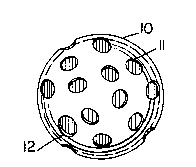Some of the information on this Web page has been provided by external sources. The Government of Canada is not responsible for the accuracy, reliability or currency of the information supplied by external sources. Users wishing to rely upon this information should consult directly with the source of the information. Content provided by external sources is not subject to official languages, privacy and accessibility requirements.
Any discrepancies in the text and image of the Claims and Abstract are due to differing posting times. Text of the Claims and Abstract are posted:
| (12) Patent: | (11) CA 1274557 |
|---|---|
| (21) Application Number: | 1274557 |
| (54) English Title: | ROTATING SPHERICAL SHELL GAME OR TOY |
| (54) French Title: | JEU OU JOUET SPHERIQUE A COQUES TOURNANTES |
| Status: | Expired and beyond the Period of Reversal |
| (51) International Patent Classification (IPC): |
|
|---|---|
| (72) Inventors : |
|
| (73) Owners : |
|
| (71) Applicants : |
|
| (74) Agent: | R. WILLIAM WRAY & ASSOCIATES |
| (74) Associate agent: | |
| (45) Issued: | 1990-09-25 |
| (22) Filed Date: | 1987-03-17 |
| Availability of licence: | N/A |
| Dedicated to the Public: | N/A |
| (25) Language of filing: | English |
| Patent Cooperation Treaty (PCT): | No |
|---|
| (30) Application Priority Data: | None |
|---|
ABSTRACT OF THE DISCLOSURE
A puzzle game or toy is disclosed comprising two
spherical shells made of hard plastic or metal material and
having over their surface a multiplicity of circular holes
cut therein in a random pattern, the holes being of equal
diameter with the exception of one hole having a slightly
larger diameter. The second spherical shell has an inner .
diameter slightly larger than the diameter of the first
spherical shell and mounted over the first shell such that
the two shells are freely rotatable relative to each other.
A spherical wall of metal or plastic is positioned inside
the two spherical shells and is of a diameter such that it
will pass through the two large holes but none of the other
holes.
Note: Claims are shown in the official language in which they were submitted.
Note: Descriptions are shown in the official language in which they were submitted.

2024-08-01:As part of the Next Generation Patents (NGP) transition, the Canadian Patents Database (CPD) now contains a more detailed Event History, which replicates the Event Log of our new back-office solution.
Please note that "Inactive:" events refers to events no longer in use in our new back-office solution.
For a clearer understanding of the status of the application/patent presented on this page, the site Disclaimer , as well as the definitions for Patent , Event History , Maintenance Fee and Payment History should be consulted.
| Description | Date |
|---|---|
| Letter Sent | 2014-05-07 |
| Inactive: Correspondence - MF | 2014-03-18 |
| Inactive: Office letter | 2014-03-11 |
| Inactive: IPC from MCD | 2006-03-11 |
| Inactive: Inventor deleted | 1999-08-30 |
| Inactive: Adhoc Request Documented | 1993-09-25 |
| Time Limit for Reversal Expired | 1993-03-27 |
| Letter Sent | 1992-09-25 |
| Grant by Issuance | 1990-09-25 |
There is no abandonment history.
Note: Records showing the ownership history in alphabetical order.
| Current Owners on Record |
|---|
| KAROLY KARMAN |
| Past Owners on Record |
|---|
| None |